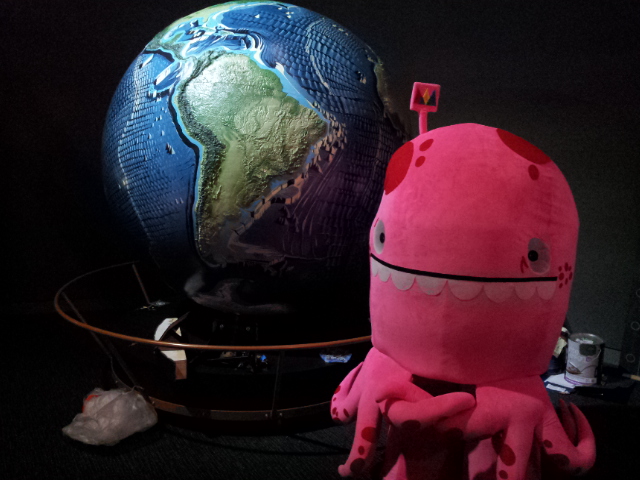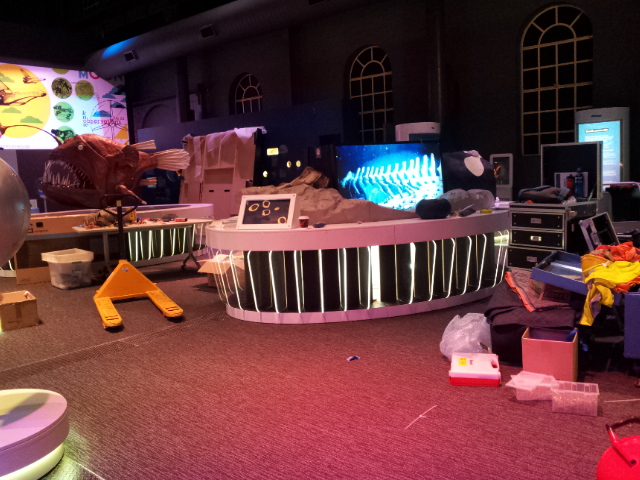On Saturday 7 December, Newcastle Museum opens the Deep Oceans exhibition and unleashes the incredible, weird, and terrifying critters that populate our deep-seas, up to 4000 metres below the water’s surface.
Newcastle Museum has actually exhibited 32 temporary, travelling or community shows since it opened its doors on 4 August 2011 but Deep Oceans is by far the biggest. The museum has completed a two-week installation moving in items such as a life-size giant squid and a 750-kilogram model of an angler fish. So what goes into an exhibition of this size?
The install itself comes down to simple “hard yakka”, says Julie Baird, Deputy Director, Newcastle Museum. They have an amazing team she calls “the Fastest Installers in the West.” They’re experienced, they know how to problem solve and because they’re small, they’re nimble, flexible and can take different roles on a dime. This means she is just as likely as other staff to be unloading objects on a rain-drenched Novocastrian day.
It’s not all hard work though. As the interactive technology from Questacon and ‘wet specimens’ from the Australian Museum come off the truck the install team feel like Christmas has come early. “We open the boxes and find wonderful things inside,” says Julie. “You put it all together and the museum transforms from blank space and chaos to a composed show that’s really special.”
Indeed, the transformation for Newcastle Museum extends to the building itself. Because of the scale of Deep Oceans, the Museum altered its layout. Staff removed and stored sections of permanent exhibitions and rearranged temporary walls. Luckily, the revamped Honeysuckle heritage site was designed for flexibility.
“Rather than a set gallery for temporary exhibitions, we have a variety of different spaces that expand and contract depending on the needs of exhibitions.”
The Deep Oceans install team feel like Christmas has come early. “We open the boxes and find wonderful things inside,” says Julie Baird. “You put it all together and the museum transforms from blank space and chaos to a composed show that’s really special.”
For a regional museum, installation is not the ultimate challenge. Rather, it’s reaching the massive audience a show like Deep Oceans deserves. Which is why the Public Programs Manager Samantha Wilcox has developed effective campaigns to build word of mouth, whether it’s on the street or online.
These campaigns are built around two ‘characters’ currently inhabiting Newcastle and surrounds: a Dumbo Octopus suit called “Inky” built and shipped from Shanghai for “less than 400 bucks” and the “Squidmobile” van. Anyone can take their picture in front of the van, post it on Facebook and voila, get a free ticket to the show. Both these campaigns turn heads, get people talking and wanting to know more.
“Angler Fish are my favourite creatures in the exhibition right now because of their parasitical mating. The female angler fish are huge and have lights to attract the guys. The male sucks on the female’s side and then slowly dissolves into the woman’s body. She just swims around the rest of her life with her ex-boyfriend attached to her.”
And what they’re marketing is special. According to Julie, Deep Oceans might be filled with cool interactives but at its heart it’s a classic “old-school” museum exhibition.
“I’m an old-fashioned museum girl. I quite like the disgusting objects in jars. Angler Fish are my favourite creatures in the exhibition right now because of their parasitical mating. The female angler fish are huge and have lights to attract the guys. The male sucks on the female’s side and then slowly dissolves into the woman’s body. She just swims around the rest of her life with her ex-boyfriend attached to her.”
Sounds like the perfect relationship.
Follow Newcastle Museum and especially the progress of Inky and the Squidmobile on Facebook.
Deep Oceans is a travelling exhibition at Newcastle Museum in partnership with the Australian Museum and Questacon. It runs from 7 December 2013 to 2 March 2014.







